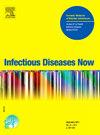Proposed macroscopic quality indicators of antimicrobial stewardship in primary care: An observational study
IF 2.2
4区 医学
Q2 INFECTIOUS DISEASES
引用次数: 0
Abstract
Objective
The objective of this study was to evaluate the ability of two macroscopic quality indicators to guide antibiotic stewardship strategies.
Methods
Setting: Bourgogne-Franche-Comté region (eight departments).
Antibiotic reimbursement data, expressed in defined daily doses, were used to calculate two macroscopic quality indicators from 2015 to 2020. Urinary tract infection indicator: (fosfomycin + nitrofurantoin + pivmecillinam) / (ciprofloxacin + ofloxacin + norfloxacin) calculated in women aged 15 to 64. Indicator for ear, nose, throat and respiratory tract infections: (amoxicillin/ (amoxicillin-clavulanate + oral 3GC) calculated in children under 15 years of age.
Results
In 2020, global antibiotic consumption varied from 22.2 to 26.6 defined daily doses per 1000 inhabitants per day, depending on the department. The macroscopic quality indicators were lowest in the departments of Nièvre and Yonne. The scores for the urinary tract infection indicator were 0.55 and 0.74, respectively, while those for the ear, nose and throat and respiratory tract infection indicators were 1.85 and 2.12, respectively. Both scores continuously increased in all departments of the region during the survey, except in 2020 for the urinary tract infection indicator, due to a nitrofurantoin shortage.
Conclusion
Even in departments with low antibiotic consumption, our macroscopic quality indicators help to identify antibiotic stewardship targets for the most common community-based infections,. They are easy to calculate from quantitative data without requiring any information on diagnosis. Complementarily to other indicators, they provide messages specifically addressed to general practitioners regarding population, molecules and diagnostic elements.
初级保健中抗菌剂管理的宏观质量指标:一项观察性研究。
目的:本研究的目的是评估两个宏观质量指标指导抗生素管理策略的能力。设置:勃艮第-弗朗什-康涅尔大区(8个部门)。以限定日剂量表示的抗生素报销数据,用于计算2015 - 2020年两项宏观质量指标。15 ~ 64岁女性尿路感染指标:(磷霉素 + 呋喃托因 + 哌美西林)/(环丙沙星 + 氧氟沙星 + 诺氟沙星)。耳、鼻、喉和呼吸道感染指标:15岁以下儿童(阿莫西林/(阿莫西林-克拉维酸 + 口服3GC) 。结果:2020年,全球抗生素消费量从每1000名居民每天22.2到26.6定义的每日剂量不等,具体取决于部门。宏观质量指标最低的是尼尼弗尔省和约讷省。尿路感染指标得分分别为0.55和0.74,耳鼻喉和呼吸道感染指标得分分别为1.85和2.12。由于呋喃妥因短缺,调查期间区域各科室除尿路感染指标在2020年外,两项得分均持续上升。结论:即使在抗生素用量较低的科室,我们的宏观质量指标也有助于确定最常见的社区感染的抗生素管理目标。它们很容易从定量数据中计算出来,而不需要任何诊断信息。作为其他指标的补充,它们还提供专门针对全科医生的关于人口、分子和诊断要素的信息。
本文章由计算机程序翻译,如有差异,请以英文原文为准。
求助全文
约1分钟内获得全文
求助全文
来源期刊

Infectious diseases now
Medicine-Infectious Diseases
CiteScore
7.10
自引率
2.90%
发文量
116
审稿时长
40 days
 求助内容:
求助内容: 应助结果提醒方式:
应助结果提醒方式:


